If your wall is filled with colorful sticky notes divided into three columns and you call that Kanban, you can expect the Kanban police to show up on your doorstep.
The simplicity of Kanban is both a good and not a really good thing. It’s a good thing because it’s easy to get started with Kanban without any special preparation. It’s not such a good thing because there’s a lot more to Kanban that it might seem at the first glance, so the initial enthusiasm quickly fades away. If you really want to know the real benefits of Kanban, keep reading.
The signal, the system, the method
Just to get ahead of those who like to argue every issue to the bitter end right at the beginning, the terms in this article are used as follows:
-
- Kanban is a “signal”, i.e. the information that something is about to happen, is happening or that it happened. For example, a sticky note that reads “Garbage!” placed in the “TO-DO” list is probably a signal to throw away the garbage, while the note which says “Wash the dishes” in the “DONE” list signals that the dishes have been washed (probably).
- A wall filled with a bunch of these notes divided into columns is a “Kanban board”, i.e. the visualization of various signals, such as the chores that need to be done around the house.
- The Kanban system is a set of “kanbans” that travel through a certain process. Visualization is only one of the elements of the Kanban system; there are also people who use the said practice of visualization along with other practices, and there’s also the element of what they discuss while standing in front of their Kanban board.
- The Kanban method is, to a certain extent, a structured approach to workflow management, i.e. the work process, whatever this work process might be.
- Kanban – any of the above mentioned definitions – doesn’t care about the content of your work.. Whether it’s the organization of chores at your home, internal IT support in your company, development of an online betting application, organization of the recruitment in your firm or literally anything else, a Kanban system will help you do it a little bit better.
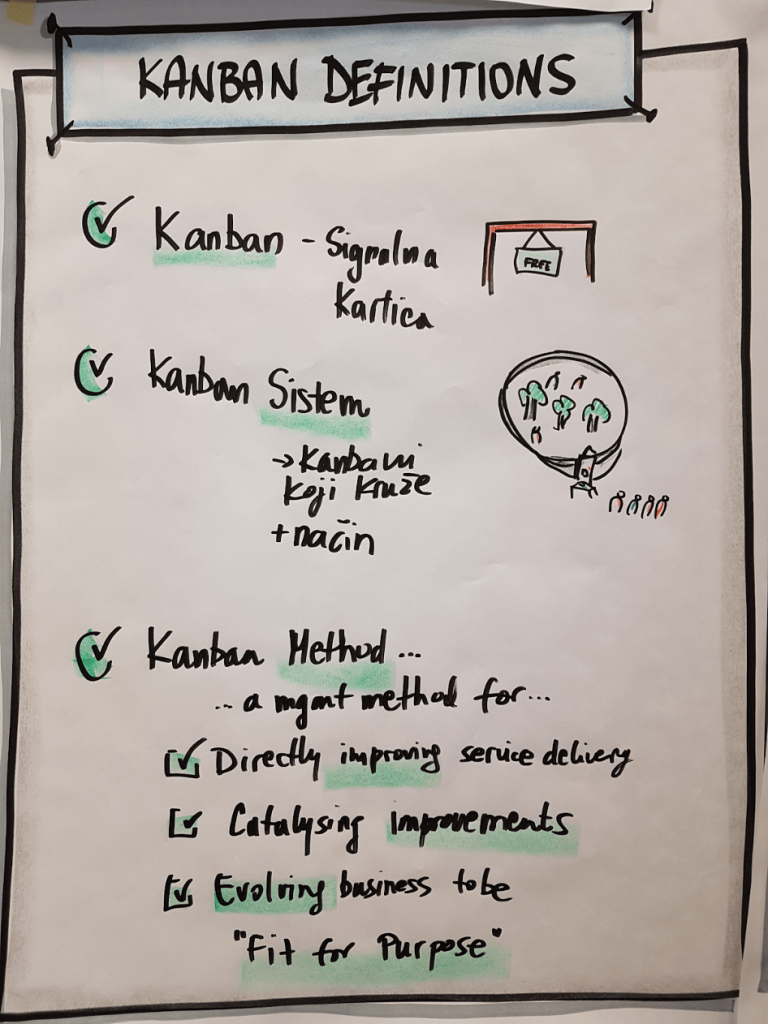
Now that we have left behind the passive-aggressive J academic discussion on the meaning of the word “Kanban” in Japanese, we can get started.
Why I’m all about the system?
Every kick in the ass is a step forward, and so is the visualization (i.e. a wall filled with colorful sticky notes). It is especially useful if you have no idea how many things you’re currently working on, and how many more are still to be done. Put it all up on the wall and prepare to be shocked.
Once you have recovered from the shock, start thinking about what needs to be done in order to get out of this situation alive.
You’ll realize the following (and kill me if I’m wrong):
-
- Your multitasking has reached unhealthy levels and you should do something about it
- Your choice of things to work on is not really the wisest, i.e. there are things that are more viable, considering the limited resources you have
- You repeat the same mistakes again and again, which then leads to the two situations mentioned above
This is where the system comes into play. Limit the multitasking. Take on new tasks only if you have the capacity to actually work on them. Set the rules on how to choose the next project. Check regularly if you’re doing everything the way you should.
Congratulations! You’re definitely getting a seal of approval the next time the Kanban police shows up on your doorstep.
“And that’s it?”
Yes, it is.
“But… But do I really need all this?”
No, of course not, but you’ll miss a real opportunity to make your life (and work) a lot easier. “Survival is optional.”
“Huh. Okay.”
That’s what I thought.
The Story of Three Columns
For many, a first encounter with Kanban is a wall divided into TO DO | DOING | DONE columns. This is a fantastic name for a blog but it’s not really the best way to visualize your work process.
Why, you ask? Well… Every process has tasks that wait to be solved, and then you need to work on them, and then they are done. How exactly can you see the crucial “steps forward” in this type o visualization? How can you get to any conclusion? This board won’t be enough to pass, sorry.

Break the “DOING” part into what you’re really doing while you’re working on something.
To illustrate: if you were Head of HR who had a task to employ some people, your “TO DO” task could be “Find a new project manager”, while your “DOING” tasks could be:
-
- Come up with the criteria
- Advertise a job vacancy
- Sort out the applications
- Shortlist the candidates
- Invite the candidates for the interview 1
- Invite the candidates for the interview 2
- Send an offer
- Sign a contract
The process of looking for a project manager could then be in a “Sort out the applications” phase, while the process of looking for a developer could be in a “Send an offer” phase. A lot more transparent than it would be if both of these were simply in a “DOING” column, isn’t it?
And think about the things you could learn about your work process if you had all the information visually represented in such detail…
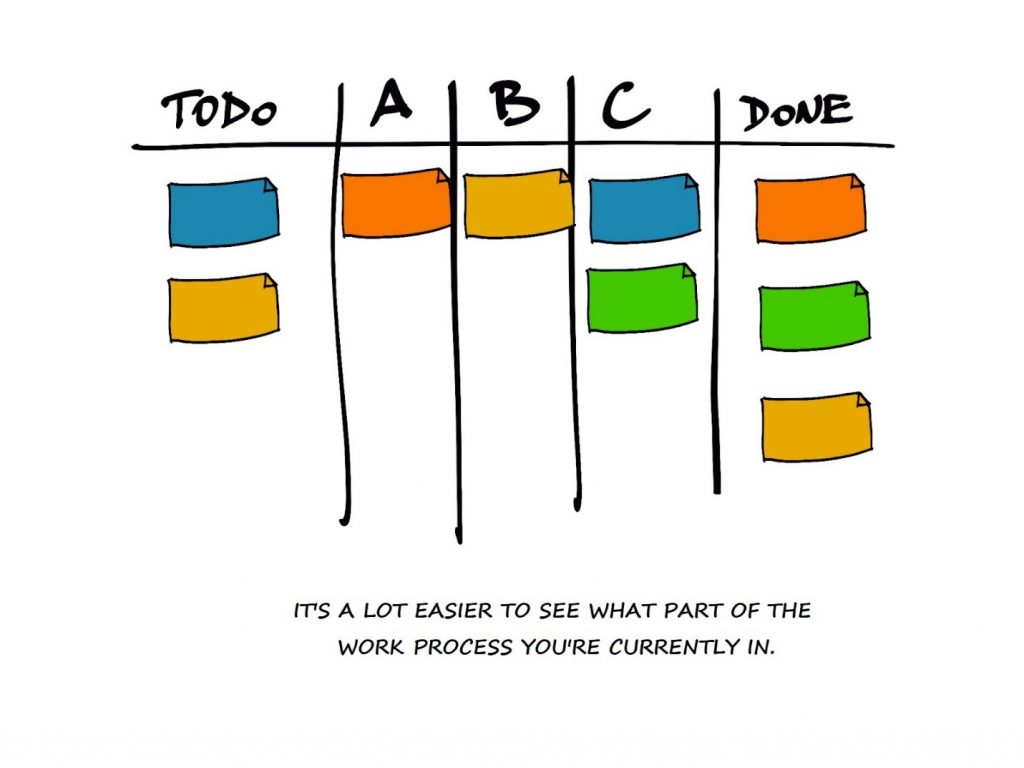
“But… These columns don’t fit every single thing we work on.”
Of course they don’t. Draw a horizontal line in the middle and divide the “DOING” part in whatever way it suits you. The Kanban board does not have to be symmetrical.
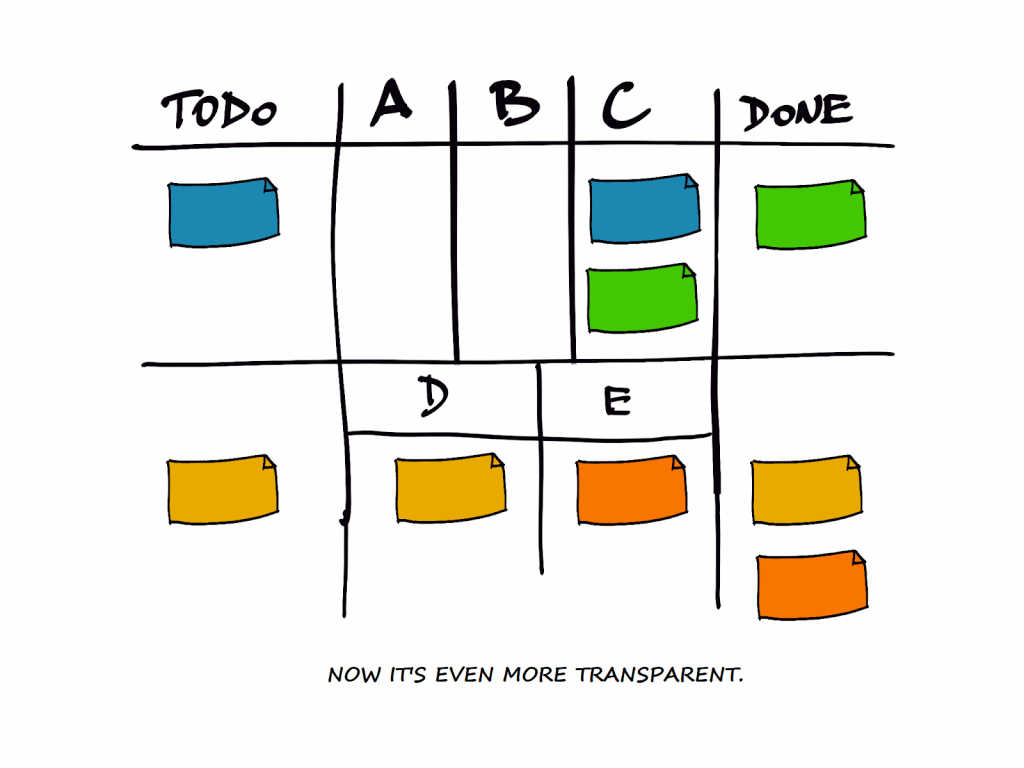
“But… But… I’ll have a whole bunch of sticky notes on my wall.”
You probably will, and it’s most likely because of the following two reasons:
-
- 1. Your multitasking has reached unhealthy levels.
How to cure it: limit the work-in-progress.
-
- 2. You’re working on the things you shouldn’t be working on.
How to cure it: don’t work on every single stupid thing somebody has posted on your colorful wall with stickies.
The true benefit is in the WIP limit
As long as you don’t limit your work in process, you won’t get the true benefits from the Kanban system. Yes, it is harsh, but it’s true.
Limit the work that’s between the “TO DO” and “DONE” column (that is, the work in the “DOING” part), and you’ll experience the benefits right away:
-
- Sounds insane, but it’s true: if you do fewer things at the same time, you’ll be done with them a lot sooner. Besides the common sense which supports this claim, there’s also a whole math behind it.
- You’ll find out what the bottleneck in the whole process is and you’ll be able to focus on solving it.
So, instead of implementing 50 new functionalities at the same time and having no time to work on anything, set the WIP limit to 49 and do not take any new work before you make room for it. And then set the WIP limit to 48, then to 47 and continue to do so until you reach a number which enables you to breathe, that is, to finish your work on time. It’s quite simple, actually.
In case of emergency
There’s another tactic that could help you breathe in your workplace: before you take a colorful paper with a task description, put it in the “TO DO” column and roll up your sleeves, take a moment to consider if it’s even necessary to work on the task.
In other words, make a difference between the “Optional” column (or “Backlog” or whatever you wish to call it) and the “TO DO” column (or “ready-steady-go” or “#definitelydoingit or any other name)
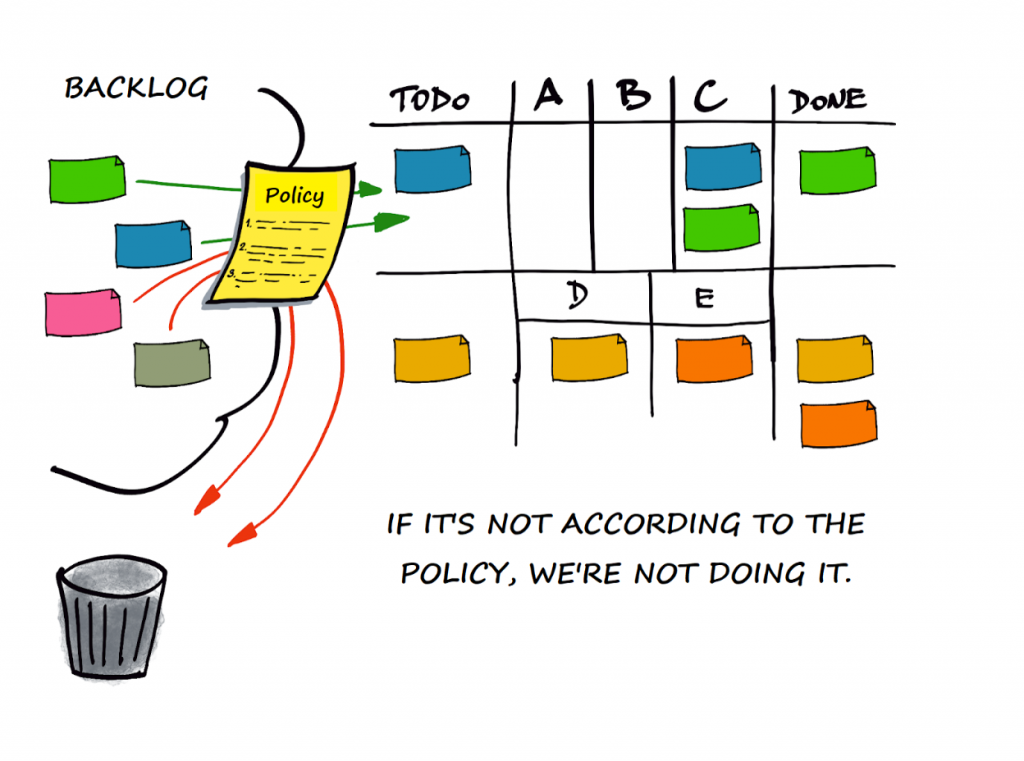
There is a whole world outside our Kanban system and the criteria to become a part of it are pretty strict. Between the outside world and the Kanban system there’s a thick line that says: Every task which fits the following criteria [here you list your criteria] will become a part of our magnificent Kanban system, it will be completed on time, and with high-quality execution or our name isn’t… [insert your team’s name].
This thick line is sometimes called the line of commitment, and the list of criteria is called the policy. What’s more, the same method could (and should) be applied whenever you proceed to the next part of work, i.e. whenever you move a sticky note to next column.
Complaints and lamentations
Every once in a while I get a “But we don’t have choice, we have to work on every task we get” type of complaint. I mean, what can I say, talk to your superiors. Kanban, unfortunately, cannot magically solve all your problems. Granted, it will help you pinpoint the problem and it will give you arguments to present to your superiors, but you will have to solve the problem yourself. People are often surprised with how reasonable their clients and superiors turn out to be.
And some Advice-To-Go
There’s no moving back
The only way you can move the sticky notes with tasks on the board is from the left to the right. When a task is completed in the A phase, it proceeds to the B phase. And there’s no moving back.
Wait, what, you can’t finish your work in the B phase because the A part was done too lousy? Too bad, but you should not return the sticky note to the previous column. Of course you’ll complete the A part while the note is in the B part but you should also ask yourself how you ended up in this situation. So, what needs to be done so that you never end up in this situation again? What needs to be changed in order to really complete the work in the A phase before transferring it to the B phase?
If you tend to move your work back, you’re missing out on the valuable information that could help you improve your work process.
Blocker is a status, not a phase
Every once in a while you get stuck while doing a part of your work and you’d like to visualize it somehow? You’ve had a brilliant idea and made a “blocked” column? You tend to put your work there, then take it out, then work on it for a bit, and then return it in the “blocked” column? This is okay but you could do a lot better.
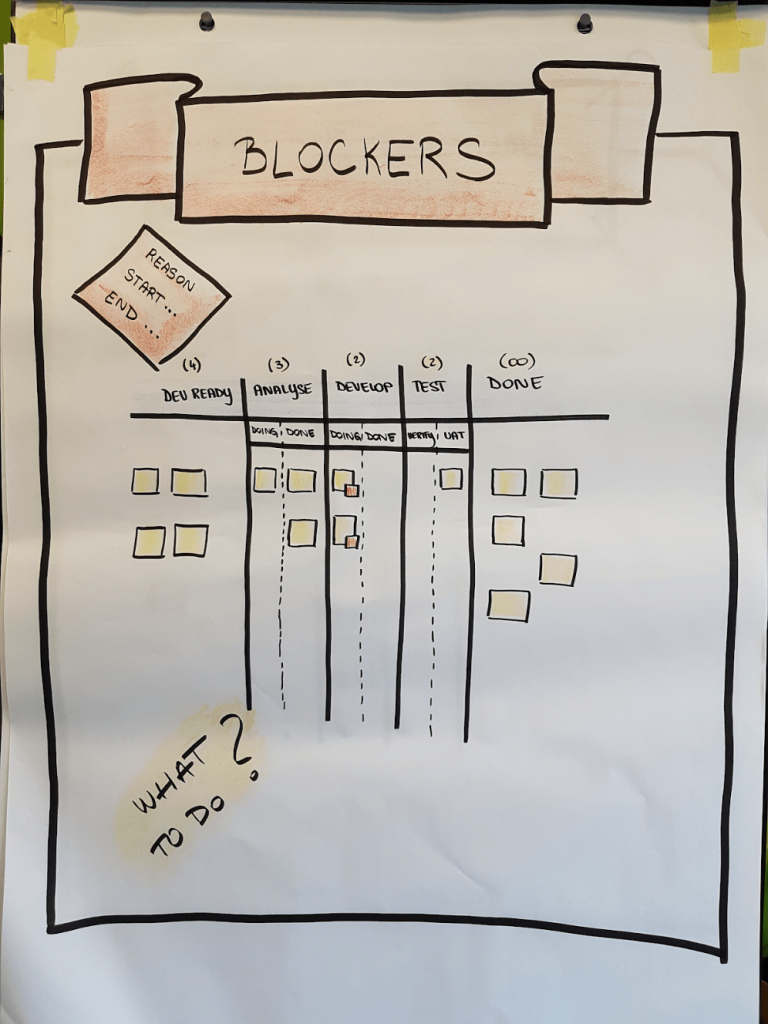
“Blocked” should be a status of a certain task, not a phase in the process. What you need to mark somehow (with a red post-it, for example) is that you’re stuck in this specific part of work. Mark the date when the “blocker” occurred, the date it ended, the reason it happened and everything else you believe would be useful in the analysis later.
These blockers shouldn’t be thrown away; you should keep them and go through them every once in a while. Why has the work been blocked? Unclear requirements? People who were supposed to help weren’t available? Issues of technical nature? There’s a lot of material to ponder over.
And yes, the work that is currently blocked also counts as work in process (WIP).
Do have a retrospective!
Using Kanban instead of Scrum does not mean you can skip the retrospective. But when are you supposed to have the retrospective phase if there are no two-week sprints? Whenever it fits you best; the important thing is to have it. FFF (Friday, four fifteen) could be a good method – use the end of your workweek to confirm the strengths and to work on the ideas on how to improve the weaknesses.
Not sure what a retrospective looks like in Kanban? The same as any other.
Speaking of…
Scrum or Kanban?
It doesn’t matter. Both methods can make you more agile.
More important than the method itself is the team using it.
To illustrate: if I had a team that was already working on something, with tasks in different phases, coming from various sources, etc., then I’d probably start with Kanban. If I had a newly-gathered team, then I’d probably start with Scrum. In the end, both teams would end up in the same place.
Of course, we also need to consider the nature of the work: do you need to work on a certain product (e.g. an app) or a process (e.g. hiring people)? If it’s a product, let’s start with Scrum; if it’s a process, let’s start with Kanban. Either way, we’ll end up in the same place eventually.
“Wait, that’s it? Now I know everything?”
The fact that you’re asking this question means that you’re probably looking at Kanban as a tool to patch up your weaknesses (which is a very short-sighted approach). Kanban is a method for change management – it will make you pay attention to developing and improving your work process. So, it’s a long-term approach, like evolution.
“Okay, now you’ve just wrecked my spirits”
That wasn’t my intention. Progress is always a good thing, even if it is in the form of an ordinary board with a sort of visualization and a sort of mutual understanding on how to use it. What’s important is to understand the benefits of the Kanban method, to roll up your sleeves and to start working on the improvement of your work process.
The Kanban system is not a magical tool you set up once and then forget about it. Just as you regularly update the OS on your phone, you need to take care of your work process and update it regularly. If you take this for granted, you’ll soon find yourself sticking colorful papers on a new, different wall. In that case, read this article once again and send out an SOS, I’ll be glad to help.
Photo by AbsolutVision on Unsplash
Related News



